Fluid mosaic model - Study guides, Class notes & Summaries
Looking for the best study guides, study notes and summaries about Fluid mosaic model? On this page you'll find 1079 study documents about Fluid mosaic model.
Page 4 out of 1.079 results
Sort by
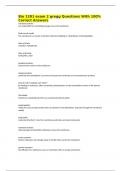
-
Bio 1201 exam 2 gregg Questions With 100% Correct Answers
- Exam (elaborations) • 10 pages • 2024
-
- $10.89
- + learn more
Bio 1201 exam 2 gregg Questions With 100% Correct Answers transport proteins are responsible for controlling passage across the membrane fluid mosaic model The membrane is a mosaic of protein molecules bobbing in a fluid bilayer of phospholipids fatty acid tails nonpolar, hydrophobic fatty acid heads hydrophilic, polar periphial proteins bound to the surface of the membrane integral proteins penetrate the hydrophobic core (ones that span the membrane are transmemb...
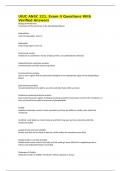
-
UIUC ANSC 221, Exam II Questions With Verified Answers
- Exam (elaborations) • 11 pages • 2024
-
- $11.49
- + learn more
UIUC ANSC 221, Exam II Questions With Verified Answers Biological Membranes Framework of the membrane is the phospholipid bilayer Hydrophobic water fearing region, faces in Hydrophilic water living region, faces out Fluid-mosaic model membrane is considered a mosaic of lipid, protein, and carbohydrate molecules Integral/Intrinsic membrane proteins transmembrane and lipid-anchored proteins Transmembrane proteins One or more regions that are physically embedded in t...
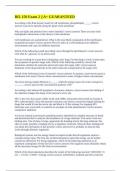
-
BIL 150 Exam 2 || A+ GUARANTEED
- Exam (elaborations) • 8 pages • 2024
- Available in package deal
-
- $11.39
- + learn more
According to the fluid mosaic model of cell membranes, phospholipids _____. correct answers Can move laterally along the plane of the membrane Why are lipids and proteins free to move laterally? correct answers There are only weak hydrophobic interactions in the interior of the membrane Cell membranes are asymmetrical. What is the most likely explanation of the membranes asymmetrical nature? correct answers The two sides of a cell membrane face different environments and carry out differen...

-
Brooks Biological Principles Exam 2 Latest Update with Verified Solutions
- Exam (elaborations) • 38 pages • 2024
-
- $11.49
- + learn more
Cytology the study of cells Cell Theory all living things are composed of cells and come from living cells Robert Hooke one of the first to use microscope, observing a piece of cork from the stem of plants, where he found chambers arising in the idea of a cell. Light Microscope takes pictures of large atoms. nucleus, not electrons Scanning Electron Microscope electrons are reflected off of a specimen and are analyzed by a computer to create a 3D image Transmission Electron Microscope Mic...
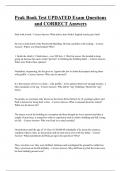
-
Zoo 250 Peak Test 1 Review UPDATED Exam Questions and CORRECT Answers
- Exam (elaborations) • 16 pages • 2024
-
- $9.49
- + learn more
Zoo 250 Peak Test 1 Review UPDATED Exam Questions and CORRECT Answers In the fluid mosaic model, these molecules make up the bilayer found in the cell membrane - Correct Answer- Phospholipids This membrane protein, made of glycoproteins and glycolipids, allows cells to identify one another or other molecules: - Correct Answer- Marker molecules
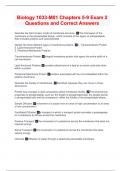
-
Biology 1033-M01 Chapters 5-9 Exam 2 Questions and Correct Answers
- Exam (elaborations) • 18 pages • 2024
-
Available in package deal
-
- $9.99
- + learn more
Describe the fluid-mosaic model of membrane structure. The framework of the membrane is the phospholipid bilayer, which consists of two layers of phospholipids. Also includes proteins and carbohydrates. Identify the three different types of membrane proteins. 1. Transmembrane Protein 2. Lipid-Anchored Protein 3. Peripheral Membrane Proteins Transmembrane Protein integral membrane protein that spans the entire width of a cell membrane Lipid-Anchored Proteins covalent attachment of a lipid to a...

-
MICR 271 EXAM QUESTIONS WITH ALL REVISED ANSWERS
- Exam (elaborations) • 21 pages • 2024
-
Available in package deal
-
- $13.29
- + learn more
MICR 271 EXAM QUESTIONS WITH ALL REVISED ANSWERS O-Antigen in lipopolysaccharide - Answer-may contain hundreds of repeating units that are species specific - external to the cell, accessible for interactions with immune cells Core in lipopolysaccharide - Answer-formed by an array of sugars including ketodeoxyoctonate - inner core is external to the membrane, but close to the surface of the cell - cross links ionically with other components of the membrane Lipid A in lipopolysaccharide...
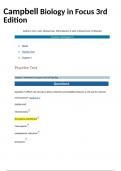
-
Campbell Biology in Focus 3rd Edition
- Exam (elaborations) • 105 pages • 2024
-
- $15.99
- + learn more
1. Home 2. Practice Test 3. Chapter 5 Practice Test Chapter 5: Membrane Transport and Cell Signaling Question1 Question 1:Which cell structure allows selective permeability between a cell and its external environment? (Section 5.1) SHOW HINT mitochondria the plasma membrane chloroplasts endoplasmic reticulum lysosomes right answer feedback:The plasma membrane allows some substances to cross into a cell more easily than others. Question2 Question 2:Which statement about the role ...

-
PATHOPHYSIOLOGY 8TH EDITION MCCANCE TEST BANK NURSINGTB.COM
- Exam (elaborations) • 1628 pages • 2024
-
Available in package deal
-
- $17.99
- + learn more
PATHOPHYSIOLOGY 8TH EDITION MCCANCE TEST BANK NURSINGTB.COM The lysosomal membrane acts as a protective shield between the powerful digestive enzymes within the lysosome and the cytoplasm, preventing their leakage into the cytoplasmic matrix. Disruption of the membrane by various treatments or cellular injury leads to a release of the lysosomal enzymes, which can then react with their specific substrates, causing cellular self-digestion. The other options do not correctly describe this pr...
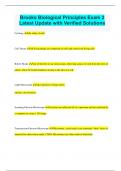
-
Brooks Biological Principles Exam 2 Latest Update with Verified Solutions
- Exam (elaborations) • 38 pages • 2024
- Available in package deal
-
- $10.99
- + learn more
Brooks Biological Principles Exam 2 Latest Update with Verified Solutions Cytology the study of cells Cell Theory all living things are composed of cells and come from living cells Robert Hooke one of the first to use microscope, observing a piece of cork from the stem of plants, where he found chambers arising in the idea of a cell. Light Microscope takes pictures of large atoms. nucleus, not electrons Scanning Electron Microscope electrons are reflected off of a specimen and ...

How much did you already spend on Stuvia? Imagine there are plenty more of you out there paying for study notes, but this time YOU are the seller. Ka-ching! Discover all about earning on Stuvia


